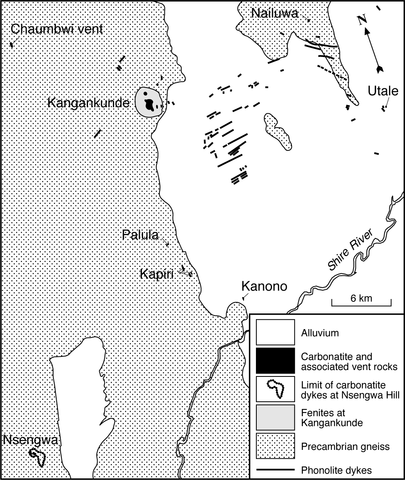stripes
Nsengwa Hill is a steep-sided feature rising some 350 m above the surrounding country the core of which is a plug of microsyenite that has been intruded and altered by a dyke-like body of agglomerate, carbonatite agglomerate and quartz-rich carbonatite. Within a crescentic area some two kilometres across to the east and south of the plug the Precambrian gneisses are cut by numerous small bodies of agglomerate and carbonatite agglomerate. The syenite of the plug, which is 300x190 m, contains aligned phenocrysts of perthite, pyroxene, biotite and a green-brown amphibole which in places is partly replaced by a blue sodic amphibole. An analysis of the syenite is given by Garson (1965b). The agglomerates vary from types in which the fragments are recognisable country rocks, which may be slightly fenitized, to varieties in which the fragments comprise minute laths, often aligned, of alkali feldspar with accessory apatite, carbonate and quartz. The matrix consists of tiny fragments and laths of alkali feldspar with a little brown carbonate. Garson (1965b) considered that most of the bodies of carbonatite agglomerate and carbonatite are the result of replacement of agglomerates by carbonate, quartz and fluorite. Carbonatite forms veins cutting both country rocks and agglomerates and generally consists of ankerite with minor quartz, calcite and apatite. Other varieties contain almost opaque pseudomorphs, considered to be after siderite, partly replaced by calcite. More massive carbonatites occur on the northern slopes of Nsengwa Hill and contain partly replaced fragments of agglomerate. They comprise plates of ankerite and quartz, much feldspathic material, which is sericitised and replaced by carbonate, including calcite and dolomite, apatite, barite and opaque patches; some varieties are fluorite-rich and pyrochlore and monazite have also been identified.
GARSON, M.S. 1965d. The geology of the area west of Lake Malombe, Fort Johnston District. Records, Geological Survey of Malawi, 3: 35-48.

